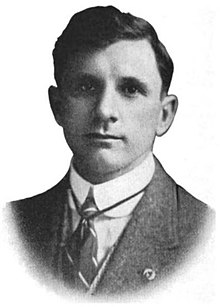This article has multiple issues. Please help improve it or discuss these issues on the talk page. (Learn how and when to remove these messages)
|
Wells Goodykoontz | |
|---|---|
 From 1918's West Virginia Legislative Hand Book and Manual and Official Register | |
| Member of the U.S. House of Representatives from West Virginia's 5th district | |
| In office March 4, 1919 – March 3, 1923 | |
| Preceded by | Edward Cooper |
| Succeeded by | Thomas Jefferson Lilly |
| President of the West Virginia Senate | |
| In office 1917 – December 1, 1918 | |
| Preceded by | Edward T. England |
| Succeeded by | Charles A. Sinsel |
| Personal details | |
| Born | June 3, 1872 Newbern, Virginia |
| Died | March 2, 1944 (aged 71) Cincinnati, Ohio |
| Resting place | Williamson, West Virginia |
| Political party | Republican |
| Spouse | Irene Hooper (m. 1898-1944, his death) |
| Alma mater | Washington and Lee University School of Law |
| Profession | Attorney |
Wells Goodykoontz (June 3, 1872 – March 2, 1944) was a Republican politician from the U.S. state of West Virginia who served in the West Virginia Legislature representing Mingo County. He was President of the West Virginia Senate from 1917 to 1919, and a Member of the U.S. House of Representatives from the now-defunct 5th congressional district of West Virginia. He served during the 66th and 67th United States Congresses.
Goodykoontz was born near Newbern, Virginia in Pulaski County on June 3, 1872. He was educated under private tutors and attended Oxford Academy at Floyd, Virginia and Washington and Lee University School of Law. He was admitted to the bar in 1893 and began practicing law at Williamson, West Virginia in 1894. He also worked in banking.
He served as a member of the West Virginia House of Delegates in 1911 and 1912. He then served as a member of the State Senate from 1914 to 1918. He was President of the Senate and Lieutenant Governor (ex officio) from 1917 until December 1, 1918.
He served as president of the West Virginia Bar Association in 1917 and 1918. He chaired the central legal advisory board for West Virginia during the First World War. In 1918, he won election as a Republican to the Sixty-sixth Congress and in 1920, won re-election to the Sixty-seventh Congress (March 4, 1919 – March 3, 1923). His candidacy for re-election in 1922 to the Sixty-eighth Congress was unsuccessful. He returned to his law practice and banking interests in Williamson as well as becoming a writer. He died in Cincinnati on March 2, 1944. He was buried at Fairview Cemetery in Williamson.